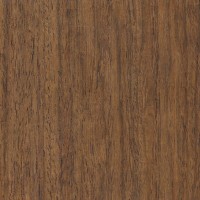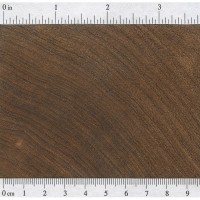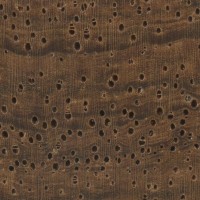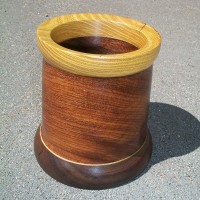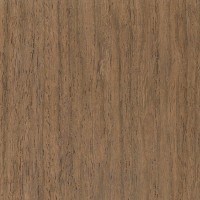 |
Common Name(s): Yucatan Rosewood, Panama Rosewood, Nicaraguan Rosewood Scientific Name: Dalbergia tucurensis Distribution: Central and South America Tree Size: 65-100 ft (20-30 m) tall, 2-3 ft (.6-1 m) trunk diameter Average Dried Weight: 42 lbs/ft3 (680 kg/m3) Specific Gravity (Basic, 12% MC): .58, .68 Janka Hardness: 1,210 lbf (5,400 N) Modulus of Rupture: 10,160 lbf/in2 (70.1 MPa) Elastic Modulus: 1,125,000 lbf/in2 (7.76 GPa) Crushing Strength: 5,260 lbf/in2 (36.2 MPa) Shrinkage: Radial: 5.0%, Tangential: 6.8%, Volumetric: 9.9%, T/R Ratio: 1.4 |
Color/Appearance: Typically a cinnamon brown, heartwood color can be highly variable, ranging from a light brown to a deep, russet brown. Grain tends to be somewhat bland, but darker streaks or swirled grain is occasionally present. Sharply demarcated sapwood is pale yellow. Overall appearance is very similar to Honduran Rosewood.
Grain/Texture: Grain is straight to interlocked. With a medium texture to fine texture, with large open pores, giving it a somewhat uneven feel. Moderate natural luster.
Endgrain: Diffuse-porous or semi-diffuse porous; medium to very large pores in no specific arrangement, very few to few; solitary and radial multiples of 2-3; heartwood deposits (reddish brown) occasionally present; growth rings usually distinct due to increased pore size and frequency in earlywood; narrow rays not visible without lens, spacing fairly close to close; parenchyma diffuse-in-aggregates, vasicentric, winged, and banded.
Rot Resistance: Rated as durable; moderate insect/borer resistance.
Workability: Overall easier to work than other rosewoods, most likely on account of its lower density. Yucatan Rosewood also seems to have a lower oil content than other oily Dalbergia rosewoods, so gluing and finishing properties are somewhat better. Turns well and takes a nice polish.
Odor: Unlike other rosewoods, Yucatan Rosewood has little to no scent while being worked.
Allergies/Toxicity: Yucatan Rosewood is claimed to have a decreased occurrence of adverse health effects and allergic reactions. Its lack of odor would suggest the wood to be of a different chemistry than other Dalbergia species. See the articles Wood Allergies and Toxicity and Wood Dust Safety for more information.
Pricing/Availability: Prices are in the low to mid range for an imported tropical species. Yucatan Rosewood is certainly much cheaper than most other Dalbergia species such as Cocobolo or Kingwood. At the time of this writing, (2011), Yucatan Rosewood is fairly new to the mainstream wood market, so it’s hard to tell if prices will remain stable, or increase due to over-harvesting—as is the unfortunate case with so many species within the genus. It is usually sold in the form of turning wood, or in thin or small stock sizes.
Sustainability: Although Yucatan Rosewood is not evaluated on the IUCN Red List of Threatened Species, it is listed on CITES appendix II under the genus-wide restriction on all Dalbergia species—which also includes finished products made of the wood.
Common Uses: Turned objects, musical instruments, furniture, and small specialty wood objects.
Comments: Known more commonly as Panama Rosewood among guitar-makers. Mistakenly sold as Dalbergia yucatensis among many retailers selling turning blanks, the scientific name is not listed or recognized by any authoritative scientific source, and is more than likely Dalberiga tucurensis.
- African Blackwood (Dalbergia melanoxylon)
- Amazon Rosewood (Dalbergia spruceana)
- Bois de Rose (Dalbergia maritima)
- Brazilian Rosewood (Dalbergia nigra)
- Burmese Blackwood (Dalbergia cultrata)
- Burmese Rosewood (Dalbergia oliveri)
- Cocobolo (Dalbergia retusa)
- East Indian Rosewood (Dalbergia latifolia)
- Honduran Rosewood (Dalbergia stevensonii)
- Kingwood (Dalbergia cearensis)
- Madagascar Rosewood (Dalbergia baronii)
- Siamese Rosewood (Dalbergia cochinchinensis)
- Sissoo (Dalbergia sissoo)
- Tulipwood (Dalbergia decipularis)


